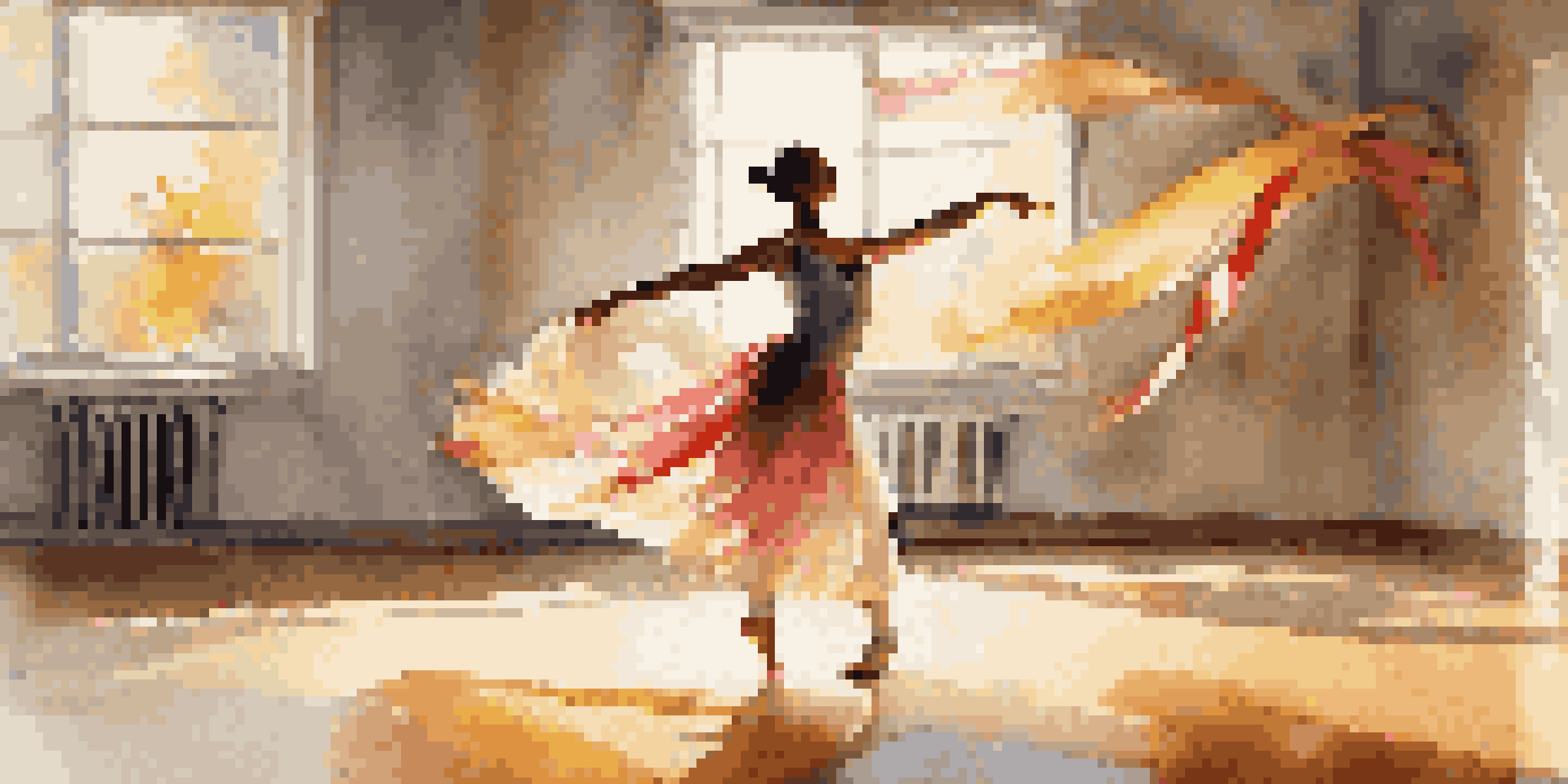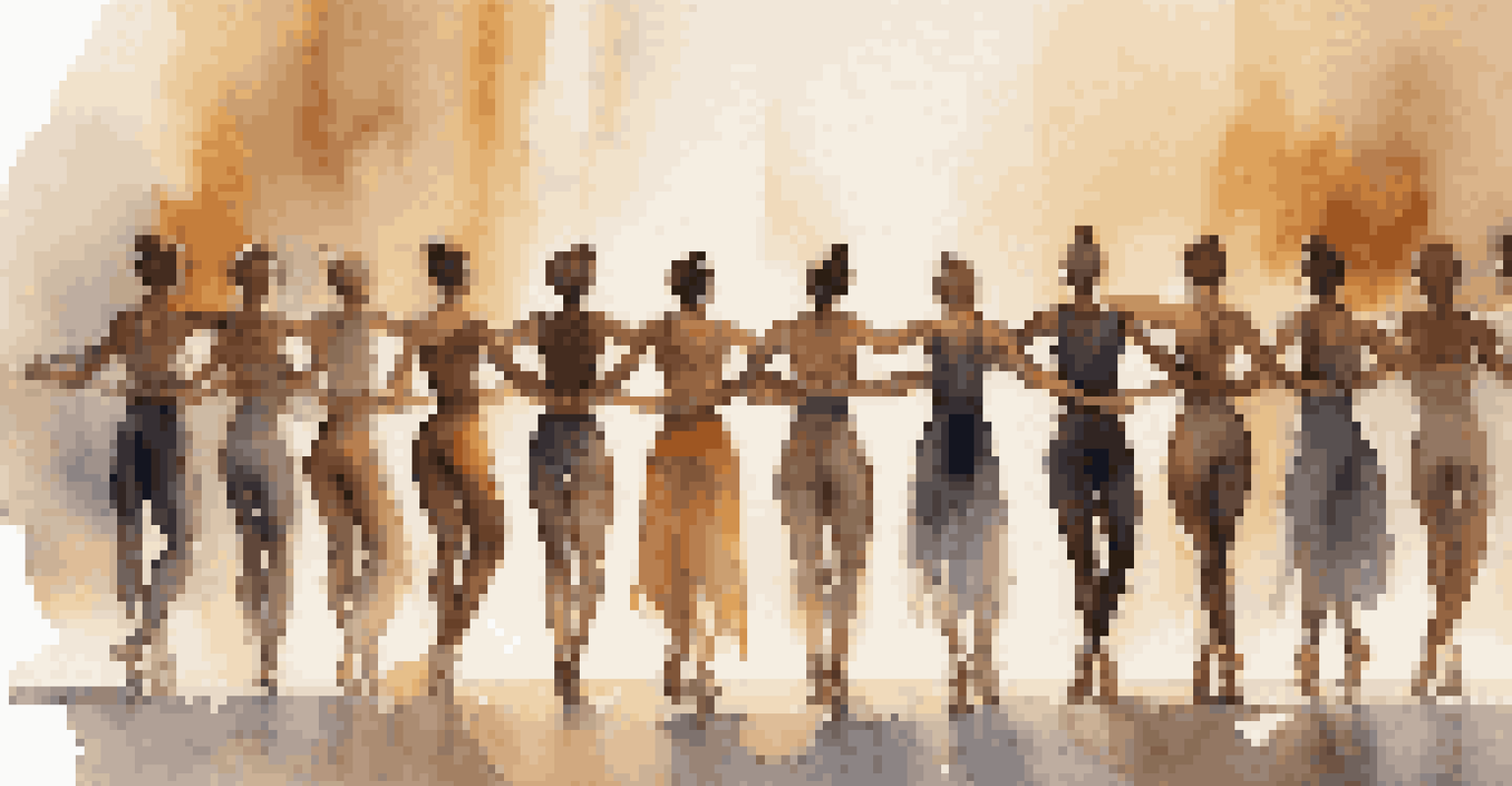Choreographic Techniques for Non-Verbal Emotional Expression

Understanding Non-Verbal Emotional Expression in Dance
Non-verbal emotional expression in dance is a powerful way to convey feelings without words. Dancers utilize their bodies to communicate complex emotions, allowing audiences to connect on a deeper level. This technique can be particularly effective in storytelling through movement, where the absence of dialogue opens up a world of interpretive possibilities.
Dance is the hidden language of the soul.
By focusing on body language, facial expressions, and movement dynamics, choreographers can create pieces that resonate emotionally. For instance, a dancer's posture or a slight tilt of the head can evoke feelings of sadness or joy, making the performance feel alive and relatable. This approach invites viewers to engage with the emotional landscape of the choreography.
Ultimately, understanding how to express emotions non-verbally expands the tools available to choreographers. It emphasizes the importance of movement as a language of its own, capable of transcending cultural and linguistic barriers. This exploration of emotional expression can lead to more impactful performances that linger in the minds of audiences long after the curtain falls.
The Role of Body Language in Dance
Body language is crucial in conveying emotions through dance. Dancers can communicate a wide range of feelings, from elation to despair, simply through their movements. For example, open arms can symbolize acceptance and warmth, while closed or hunched shoulders may convey feelings of sadness or defensiveness.

Choreographers often design movements that align closely with emotional themes, allowing dancers to embody the essence of the story being told. This connection between body language and emotion can enhance the overall impact of a performance, making it more relatable to the audience. The subtle nuances in a dancer's movement can speak volumes, often more than words ever could.
Dance Communicates Without Words
Non-verbal emotional expression in dance allows dancers to convey complex feelings, creating a deeper connection with the audience.
Moreover, body language in dance allows for a shared emotional experience between performers and viewers. When dancers express genuine feelings through their movements, they create a bridge of empathy, inviting the audience to feel along with them. This connection is what makes dance a uniquely powerful form of storytelling.
Using Space to Convey Emotion
The use of space in choreography is another effective technique for non-verbal emotional expression. Dancers can manipulate the space around them to create feelings of isolation, freedom, or tension. For instance, moving closely together can signify intimacy, while distancing can evoke loneliness or conflict.
The dance is a poem of which each movement is a word.
Choreographers often consider the spatial relationships between dancers to enhance the emotional narrative. A sudden shift in formation or spacing can dramatically alter the mood of a piece, emphasizing feelings of chaos or harmony. This dynamic use of space invites the audience to interpret the emotional undercurrents of the performance.
Furthermore, how dancers interact with the space itself—whether they fill it with expansive movements or inhabit it with subtle gestures—adds layers to the emotional expression. By effectively using space, choreographers can deepen the audience's connection to the performance, making the experience more immersive and impactful.
Facial Expressions as a Tool for Emotion
Facial expressions play a vital role in non-verbal emotional expression within dance. A dancer's face can convey joy, sorrow, anger, or fear, often complementing their movements. For example, a beaming smile paired with energetic jumps can exude happiness, while a furrowed brow during a slow, deliberate movement might express sadness or contemplation.
Choreographers often emphasize the importance of facial expressions when crafting their pieces. By instructing dancers to embody specific emotions through their faces, they enhance the overall storytelling aspect of the performance. This attention to detail helps create a richer, more engaging experience for the audience.
Body Language Enhances Storytelling
Subtle movements and body language in dance serve as powerful tools to express emotions, making performances more relatable and impactful.
Moreover, the connection between facial expressions and movement allows for a more profound exploration of emotion. When both elements align harmoniously, the impact of the performance is magnified, drawing viewers into the emotional journey of the dancers. This synergy can leave a lasting impression, making the performance unforgettable.
Rhythm and Timing in Emotional Expression
Rhythm and timing are crucial elements in dance that significantly influence emotional expression. The way dancers move in relation to the music can evoke specific feelings, with faster tempos often conveying excitement or urgency, while slower rhythms may elicit calmness or introspection. This interplay between rhythm and emotion creates a compelling narrative.
Choreographers carefully consider the timing of movements to enhance emotional impact. For example, a sudden pause can heighten tension or create anticipation, while a fluid continuation of movement can evoke a sense of serenity. Such deliberate choices in rhythm contribute to the overall emotional arc of the performance.
Furthermore, the synchronization of movements among dancers can amplify emotional expression. When a group performs in unison, it can create a powerful sense of unity, while contrasting movements can suggest conflict or tension. This rhythmic interplay invites the audience to experience the emotions conveyed through the dance, making it a dynamic and engaging art form.
Cultural Influences on Emotional Expression in Dance
Cultural backgrounds greatly influence how emotions are expressed through dance. Different cultures have unique ways of conveying feelings, often rooted in their history, traditions, and artistic practices. For example, traditional African dance may emphasize community and celebration, while ballet might focus on grace and elegance.
Choreographers often draw from these cultural influences to enrich their work. By incorporating elements from various dance styles, they can create a more diverse and nuanced emotional expression. This blending of cultural techniques allows for a broader exploration of feelings and narratives, making the dance more relatable to diverse audiences.
Cultural Roots Shape Emotional Expression
Cultural influences significantly affect how emotions are portrayed in dance, enriching the narrative and connecting with diverse audiences.
Moreover, understanding cultural influences helps dancers connect more authentically with the emotions they portray. When performers embrace their cultural heritage, it adds depth and authenticity to the emotional expression, resonating more powerfully with viewers. This cultural richness can transform a dance piece into a profound experience that transcends boundaries.
The Importance of Practice in Emotional Expression
Practice is essential for dancers to master the art of non-verbal emotional expression. Through repetition and refinement of movements, dancers can learn to embody emotions with greater authenticity and precision. This ongoing practice allows performers to explore the emotional nuances of their choreography more deeply.
Choreographers often encourage dancers to connect personally with the emotions they convey. This might involve reflecting on their own experiences to bring genuine feelings into their performance. The more a dancer practices expressing these emotions, the more natural it becomes, leading to a more compelling performance.

Ultimately, the commitment to practice not only enhances technical skills but also deepens emotional expression. It cultivates a sense of confidence and authenticity in dancers, enabling them to connect with their audience on a profound level. This dedication to honing their craft is what transforms a good performance into a great one.